The Dutch Marine Corps Rifle Platoon, 1963
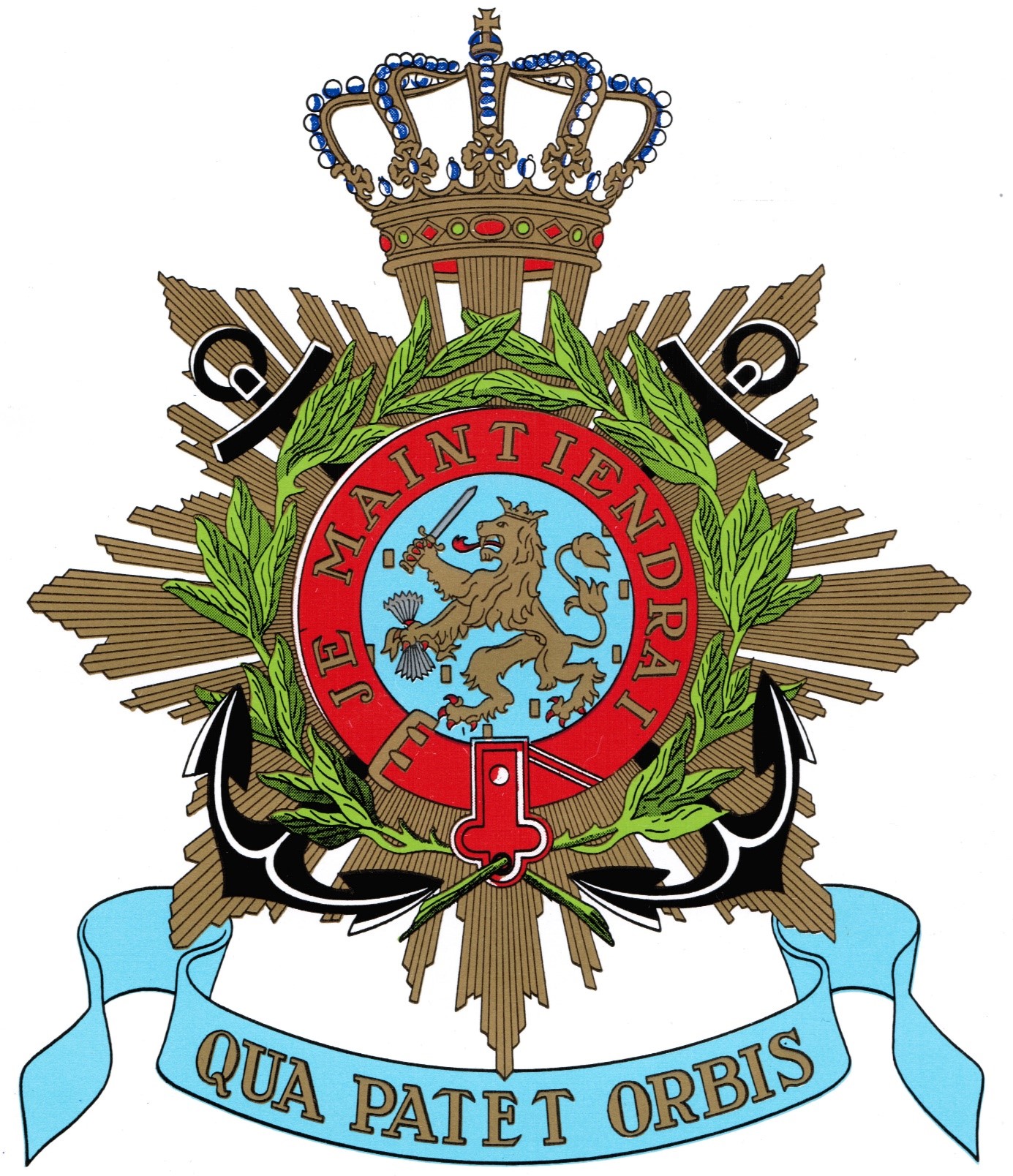
Introduction
Following the loss of Dutch New Guinea in 1962,
the Dutch marine corps found itself between a rock and a hard place.
Indeed, the possibility of dissolving the nearly 300-year old corps was discussed.
Nonetheless, the Korps Mariniers continued to modernize, replacing its American weapons acquired in
the 1943-1945 period. Whilst the M1911A1 and Thompson M1 had been replaced in 1958 and 1959 respectively,
the Garand and M1918A2 BAR were soon to follow. With these new weapons, so too the organisation changed.
Prologue
This post is based on the
Voorontwerp van een voorschrift betreffende de tactiek van de geweergroep, dated 1st of June, 1963.
As a provisional manual, it is hard to say with certainty how long the organisation
described was in use. Nonetheless, it provides us with a look at how the
Dutch marine corps sought to incorporate its new generation of weaponry.

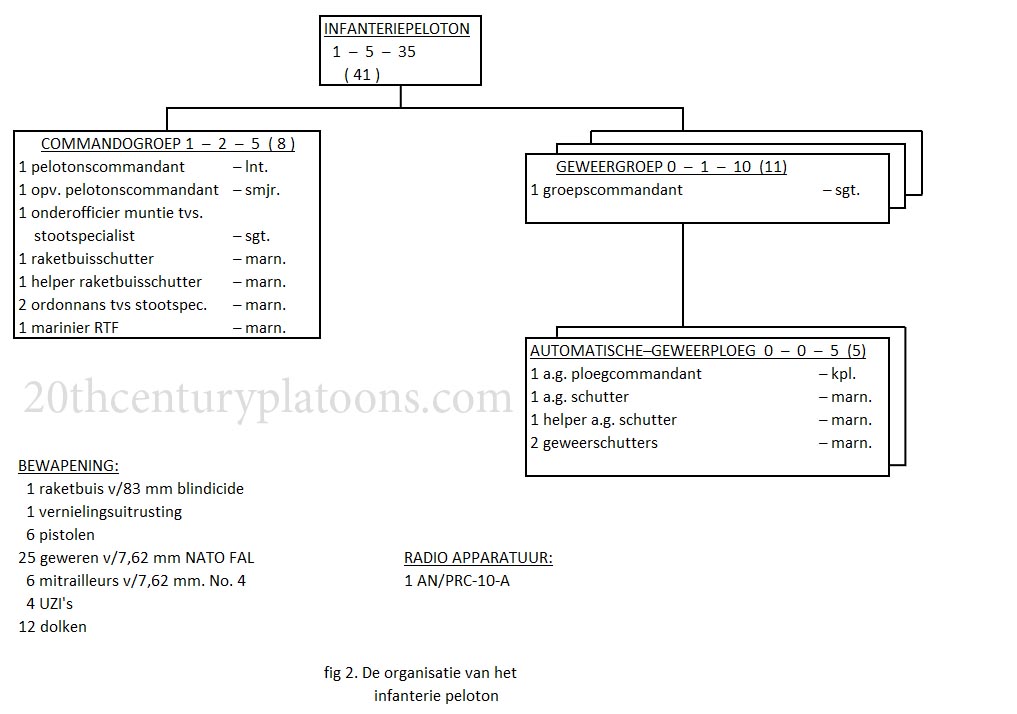
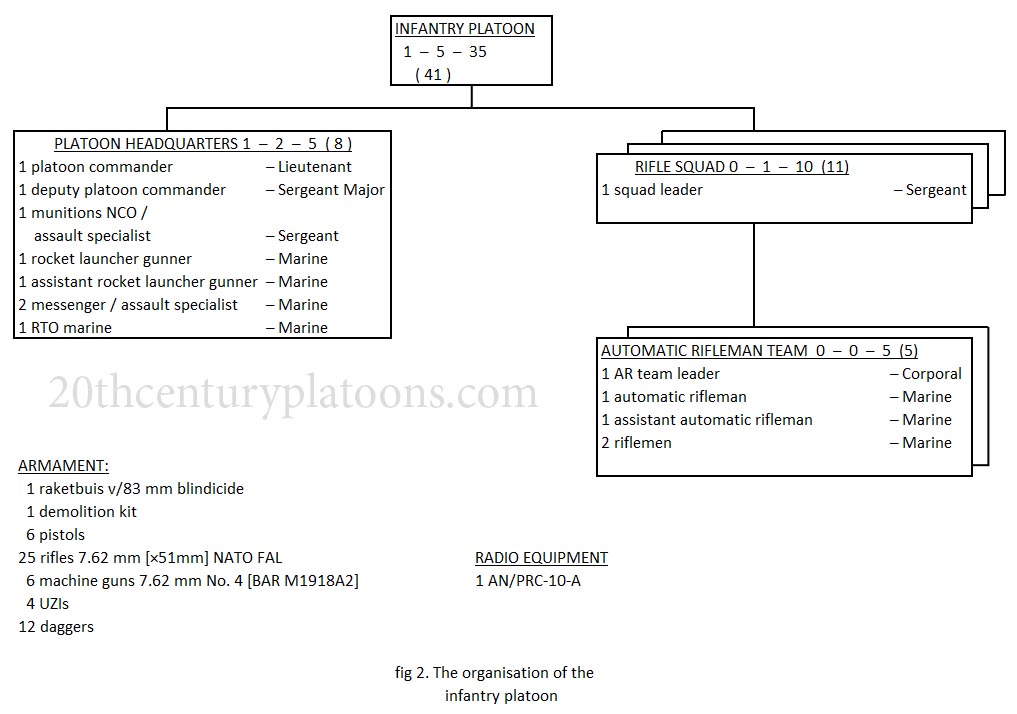

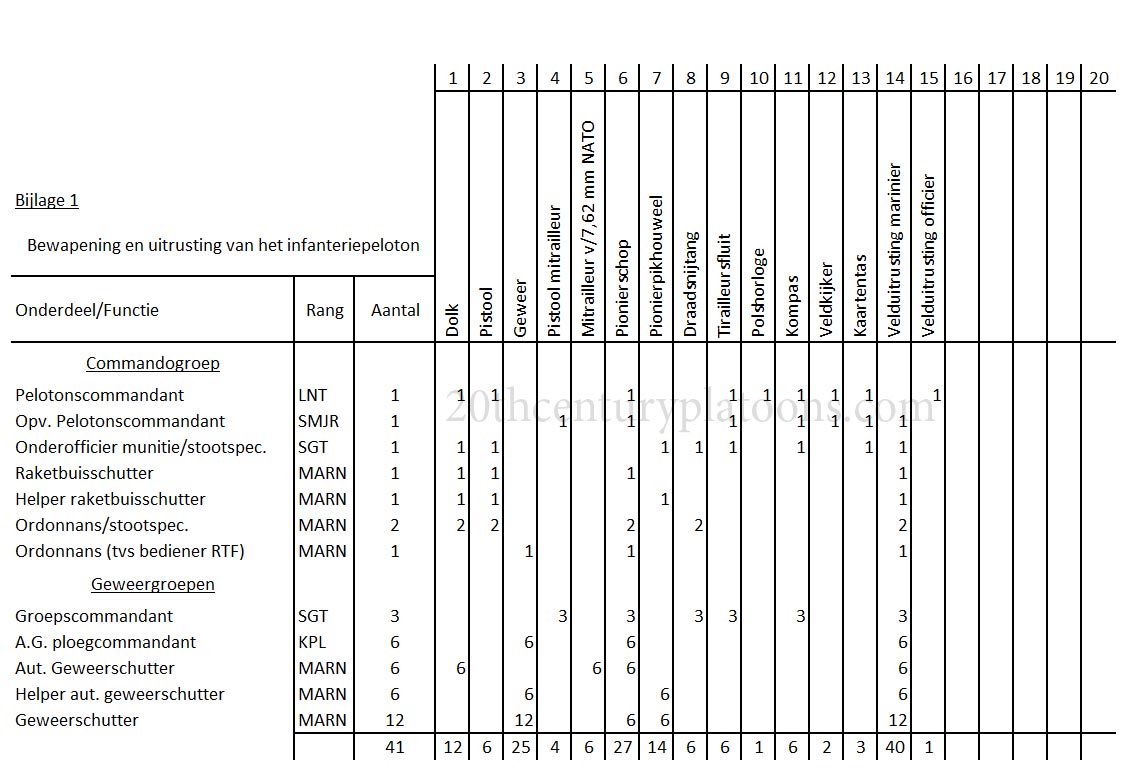
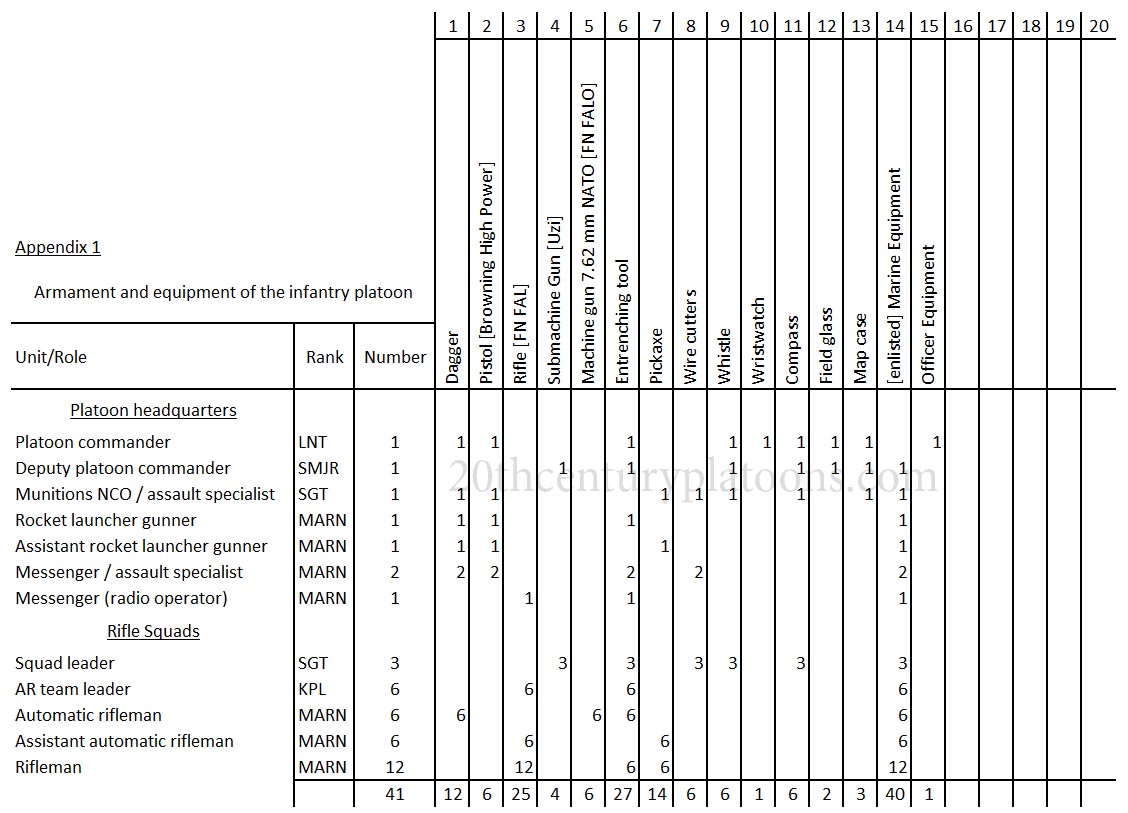
The infanteriepeloton (infantry platoon) is composed of a commandogroep (platoon headquarters) and three geweergroepen (rifle squads).
The platoon headquarters is composed of a pelotonscommandant (platoon commander), opvolgend pelotonscommandant (deputy platoon commander), onderofficier munitie / stootspecialist (munitions NCO / assault specialist), raketbuisschutter (rocket launcher gunner), helper raketbuisschutter (assistant rocket launcher gunner), two ordonnansen / stootspecialisten (messengers / assault specialists), and finally a marinier RTF (Marine radio telephone operator i.e. RTO).
The platoon commander is a luitenant (lieutenant), be it 1st or 2nd. Assisting him with commanding the platoon is the deputy platoon commander, a position which can arguably be translated as platoon sergeant as well. Very much so, the deputy platoon commander holds the rank of sergeant-majoor.
The platoon HQ does however contain another sergeant, tasked with munitions and demolitions. Indeed, he doubles as an assault specialist, trained to engage and assault bunkers and points of resistance. Commonly, this role included flamethrower training.
Next we have the rocket launcher team, consisting of a gunner and assistant gunner. Both hold the rank of marinier (literally “Marine”, but in terms of rank they are privates), either 1st or 2nd class. In any case, these ranks are OR-2.
Finally, we have three messengers holding the rank of marinier, with two of them doubling as assault specialists, whilst the third had duties as a radio telephone operator.
To give a short overview of the platoon headquarters, please see the table below.
| Role | Rank (NATO scale) | Rank | Weapon |
|---|---|---|---|
| Platoon headquarters | |||
| Platoon commander | OF-1 | Lieutenant | Browning High Power |
| Deputy platoon commander | OR-7 | Sergeant-major | Uzi |
| Munitions NCO / assault specialist | OR-6/OR-5 | Sergeant | Browning High Power |
| Rocket launcher gunner | OR-2 | Private | Browning High Power |
| Assistant rocket launcher gunner | OR-2 | Private | Browning High Power |
| Messenger / assault specialist | OR-2 | Private | Browning High Power |
| Messenger / assault specialist | OR-2 | Private | Browning High Power |
| Messenger (radio operator) | OR-2 | Private | FN FAL |
The squad
The three rifle squads accounted for both the bulk of man- and firepower. Commanded by a groepscommandant (squad leader) holding the rank of sergeant, the squad was neatly divided into two equal AG ploegen, or automatisch geweer ploegen in full. These automatic rifle teams are described below.

The automatic rifle team
The automatic rifle team consists of a ploegcommandant (team leader), automatisch geweerschutter (automatic rifleman), helper automatisch geweerschutter (assistant automatic rifleman), and two geweerschutters (riflemen).
For a short overview of the squad, see the table below.
| Role | Rank(NATO scale) | Rank | Weapon |
|---|---|---|---|
| Squad (×3) | |||
| Squad leader | OR-6/OR-5 | Sergeant | Uzi |
| Automatic rifle team (×2) | |||
| Team leader | OR-4/OR-3 | Corporal | FN FAL |
| Automatic rifleman | OR-2 | Private | FN FALO |
| Assistant automatic rifleman | OR-2 | Private | FN FAL |
| Rifleman | OR-2 | Private | FN FAL |
| Rifleman | OR-2 | Private | FN FAL |
Armament
Following the fall of the Dutch East Indies in 1942, the marine corps sought to re-establish itself as a fighting force, leading to the creation of the Mariniersbrigade, or marine brigade. As a result of this unit’s American organisation and training, it also possessed American weaponry. These weapons were replaced in the late 50s and early 60s, due to their age, and to standardize weaponry and calibres both with NATO and the other branches of the Dutch armed forces.
The first of these American weapons to be replaced were the M1911A1 (Pistool van 11,4 mm no. 1 s-aut (Colt)) and Thompson M1928A1 and M1 (Machinepistool van 11,4 mm no. 1 (Thompson) and no. 2 respectively). Their replacements were the Browning High-Power (Pistool van 9 mm, nr. 6, s-aut. (Browning FN)) and Uzi (Pistoolmitrailleur van 9 mm nr. 7, UZI).
Both were acquired in 1958, with deliveries of the Uzi delaying the issuing of both these weapons until 1959: it would be impractical to supply both .45ACP and 9mm Para.
The Browning High-Power is a 13-shot semi-automatic pistol, weighing 1.11kg (2.45 lbs) loaded. A Browning design just like the M1911A1 it replaced, the High-Power was the final design by Browning, completed by his protégé Saive. It was for a long time perhaps the best pistol available, especially given its (relatively) high capacity. The Navy’s High-Powers were distinguished by an anchor on top of the slide. .

The Uzi, on the other hand, was a rather unknown weapon at the time of its adoption. Indeed, the Dutch Air Force was the first foreign service to adopt the weapon, followed by the Navy in 1958. The specific model ordered by the Navy lacks a single-shot capability, instead having only safe and full-auto settings. Furthermore, the weapon was issued with a wooden stock, and 25-round magazines.
Weighing 3.5 kilogrammes (7.7 lbs) without a magazine whilst measuring 630 millimetres (24.8 inches), the Uzi provided a light and compact weapon to squad leaders, all the while providing great firepower at close range.

Indeed, the Uzi was quite light compared to the rifle adopted, the FN FAL (Geweer van 7,62 mm NATO, FAL, FN). Replacing the M1 Garand (Geweer van 7,62 mm no.2 s-aut. (Garand)) in 1961, the FAL brought the marines’ rifle up to NATO standards. At 5.7 kilogrammes (12.6 lbs) with a loaded 20-round magazine, the FAL represented both an increase in weight as well as firepower.

In keeping with the American-style automatic rifle-based fireteams, the big brother to the FAL was adopted: the FALO (Fusil Automatique Lourd: Rifle, Automatic, Heavy). Known in Dutch naval service as the mitrailleur van 7,62 mm NATO, FAL, FN (machine gun of 7,62 mm NATO, FAL, FN), the FALO replaced the American BAR M1918A2 (mitrailleur van 7,62 no.4).
Quite a bit lighter than the BAR at 6.7 kilos (14.8lbs) loaded with a 20-round magazine, the FALO allowed for magazine interchangeability between the rifle and automatic rifle. Even more so, it simplified training and logistics.

Finally, the platoon possessed a single anti-tank weapon, the RL-83 Blindicide (Raketbuis van 83 mm blindicide). This Belgian launcher weighs 8.4 kilogrammes with its 900m sight, and can be folded in two to reduce its length from 1700mm down to 620mm (66.9 inches to 27.2 inches). The long-range AT-rocket weighs 2.4 kg (5.3lbs) and can achieve 300mm (11.8in) of armour penetration. .

Ammunition carried
With regards to the amount of ammunition carried per weapon, the manual does not offer any information whatsoever. As such, it is necessary to make some assumptions based on other manuals, those being the Dutch Navy’s guide for landing parties (1965) , and a Belgian platoon manual which includes data on the Blindicide (1954) . Consequently, the following amounts of ammunition are likely to be carried.
| Weapon | Ammunition carried |
|---|---|
| Browning High-Power | 26 |
| Uzi | 125 |
| FN FAL | 100 |
| FN FALO (Gunner) | 260 |
| FN FALO (Assistant Gunner) | 140 |
| Blindicide (Gunner) | 2 |
| Blindicide (Assistant Gunner) | 4 |
Conclusion
In the squad layout, we can see the influence of the American USMC tactics and doctrine. As a result of the Dutch marine corps’ American training in 1943-1945, a fireteam structure centred around the automatic rifle was adopted, with three BARs to a 13-man squad. Although the squad has been reduced in size, the automatic rifle still provides the basis for the (now) two fireteams. The move from three BARs to two FALOs per squad may have been a result of – or at least lessened and partially offset by – the increased firepower offered by the eight FALs compared to the twelve Garands. It is however worth noting that the US Marine Corps maintained the three-fireteam structure into Vietnam.
Without any 1950s era manuals to confirm this theory, it remains, however, speculation. In the next posts on the 1978 and 1996 Dutch marine corps platoon organisational structure, I hope to examine how the platoon evolved further.
Footnotes
